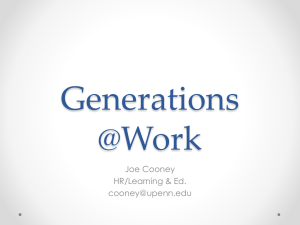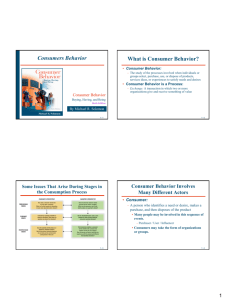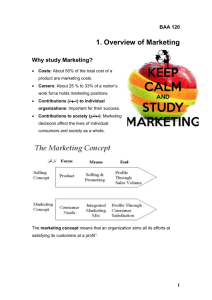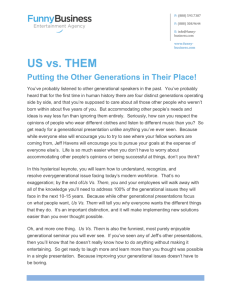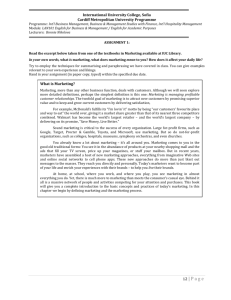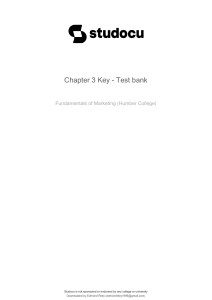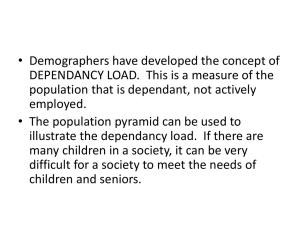Team B - International Business courses
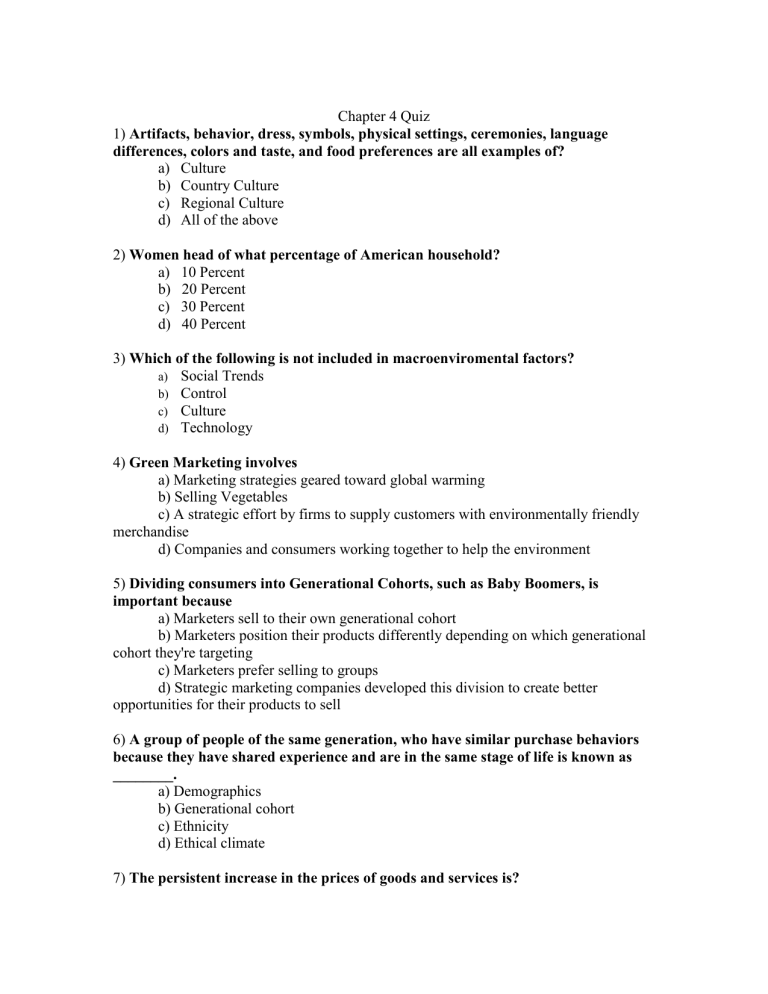
Chapter 4 Quiz
1) Artifacts, behavior, dress, symbols, physical settings, ceremonies, language differences, colors and taste, and food preferences are all examples of?
a) Culture b) Country Culture c) Regional Culture d) All of the above
2) Women head of what percentage of American household? a) 10 Percent b) 20 Percent c) 30 Percent d) 40 Percent
3) Which of the following is not included in macroenviromental factors? a) b) c) d)
Social Trends
Control
Culture
Technology
4) Green Marketing involves
a) Marketing strategies geared toward global warming
b) Selling Vegetables
c) A strategic effort by firms to supply customers with environmentally friendly merchandise
d) Companies and consumers working together to help the environment
5) Dividing consumers into Generational Cohorts, such as Baby Boomers, is important because
a) Marketers sell to their own generational cohort
b) Marketers position their products differently depending on which generational cohort they're targeting
c) Marketers prefer selling to groups
d) Strategic marketing companies developed this division to create better opportunities for their products to sell
6) A group of people of the same generation, who have similar purchase behaviors because they have shared experience and are in the same stage of life is known as
________.
a) Demographics
b) Generational cohort
c) Ethnicity
d) Ethical climate
7) The persistent increase in the prices of goods and services is?
a) Economic situation
b) Interest rates
c) Inflation
d) Foreign currency fluctuations
8) Which of the following are involved with the macroenviroment?
a) Technoligical Advances
b) Social Issues
c) Demographics d) All of the above
9) Which of the following is not a way that the macroenviroment effects the economy?
a) Competition b) Corporate Partners c) Customer Marketing d) Price Stability
10) In demographics who makes up the fastest growing group"
a) Seniors
b) Baby boomers
c) Generation X
d) generation Y
11) What do interest rates represent?
a) what people are interested in
b) the cost of loaning money
c) the principle of the loan
d) the cost of borrowing money
12) What is one of Wal-Mart's strengths?
a) A good corporate citizen.
b) Sales equals 2.5 % of U.S GDP
c) Worlds largest retailer.
d) B and C are correct.
13) What are some social trends that are occuring in the U.S?
a) Time-Poor Society
b) Green Marketing
c) Buy SUV's
d) A & B are correct
14) Which generational cohort is often characterized as the hardest to market to?
a) Generation Y
b) Generation X
c) Tweens
d) Seniors
15) The persistent increase in the prices of goods and services is ______.
a) Foreign currency fluctuations
b) Interest rates
c) Inflation
d) Economic situation
16) Tariffs and trade barriers to facilitate trade among the three nations?
a) Robinson-Patman Act
b) North American Free Trade Agreement (NAFTA)
c) Wheeler-Lea Act What is the International trade agreement among Canada,
Mexico, and the United States removing
d) Federal Trade Commission
17) What refers to the persistent increase in prices of goods and services causing the power of the dollar to decline?
a) Depreciation
b) Appreciation
c) Inflation
d) None of the above
18) Which of the following is not a strategy to gather Customer Intelligence (CI) a) Guessing what customers/suppliers want.
b) Analyzing rival's marketing tactics, distribution practices, pricing, and hiring needs.
c) Interviewing customers, suppliers, partners, or former employees.
d) Reviewing public materials including websites, press releases, annual reports, subscription databases, permit applications, patent applications, and tradeshows.
19) What does JIT stand for?
a) Joint International Trading
b) Just-in-Time inventory system
c) Justice in Tactics of Business
d) Joint Income Treasury
20) In the Scenario Planning Process, identifying different scenarios is what step?
a) step five:
b) step four:
c) step two:
8.d
9.b
10.a
11.d
12.d
13.d
14.a
15.c
16.b
17.c
18.a
19.b
20.d
3.b
4.c
5.b
6.b
7.c
d) step three:
Answers:
1.b
2.c
Quiz: Chapter 4
1.
Choosing the first option that is minimally acceptable or adequate; the choice appears to meet a targeted goal or criterion which is? a.
Optimizing b.
Maximizing c.
Satisficing d.
Implementing
2.
Which of these is a disadvantage of leading? a.
Little or no competition b.
Greater risk c.
Establishment of entry barriers d.
Greater efficiency
3.
What is a strategy used to add new businesses that produce unrelated products or are involved in unrelated markets and activities? a.
Corporate strategy b.
Vertical integration c.
Low-cost strategy d.
Conglomerate diversification
4.
What is the major actions by which an organization competes in a particular industry or market a.
Business strategy b.
Concentric diversification c.
Corporate strategy d.
SWOT analysis
5.
Which of these is not a factor which affects the consumer in the immediate environment?
a. Firm's Corporate Partners
b. Competition
c. Supply Chain
d. Company
6.
Companies use this to collect and synthesize information about their position with respect to their rivals?
a. Macroenvironmental Factors
b. Competitive Intelligence
c. Competitive Edge
d. Competitive Culture
7.
Which of the following is the second step that company would follow for scenario planning?
a. Assess Opportunities and Threats
b. Apply Markgeting Mix to the Different Scenarios
c. Assess Strengths and Weaknesses
d. Assess the Profitability of each Scenario
8.
What indicates the characteristics of human populations and segments, especially those used to identify consumer markets?
A.
Development
B.
Culture
C.
Demographics
D.
Globalization
9.
The demand for green-oriented products has led to what reaction from marketers?
E.
Green marketing, this involves a strategic effort by firms to supply environmentally friendly merchandise.
F.
Treating the customer as an individual.
G.
Further promoting of community volunteering.
H.
Processing potential outcomes of different applications of a firm’s marketing mix.
10.
Technological Advances have accelerated greatly during the past few decades by doing what? a.
Supporting human rights. b.
Improving the value of both products and services. c.
Monitoring the general economic situation. d.
Supporting small producers around the world.
11.
A recent technological innovation in the marketplace that has affected consumers’ everyday activities would be? a.
Cell phones b.
LCD Televisions c.
MP3 Players d.
All of the above.
12.
The Time-Poor Society refers to: a.
Decreasing Real Wages b.
Decreasing Leisure Time c.
Decreasing Work Ethic d.
Decreasing Productivity
13.
What is one of Wal-Mart’s weaknesses? a.
They are seen as the villain in many communities b.
Low Prices c.
Lack of Supply-Chain Management d.
Lack of Technology in its distribution centers
14.
Legislation was enacted to protect consumers by: a.
Laws meant to increase competition b.
Protect customers from being misled c.
Remove anything harmful about their product d.
All of the above.
15.
What area does Walmart populate most? a.
Asia b.
Western U.S. c.
Eastern U.S. d.
Africa
16.
All of these are examples of Competitive Intelligence except: a.
Reviewing websites b.
Analyzing a company’s pricing c.
Revamping your company’s sales strategy
d.
Interviewing former employees
17.
Tweens are hard to market to because: a.
They multitask instead of paying full attention to one media b.
They get bored fast and move on c.
They have lived with technology their whole life d.
They like Gogurt
18.
What do baby boomers provide a growing market for? a.
Anti aging products b.
Khaki’s c.
Second homes d.
Luxury cars
19.
Ordering parts to get to a plant directly before they are used to lower inventory is an example of: a.
Competitive Intelligence b.
Just-in-time inventory c.
Part Pre-placement d.
Consumption planning
20.
What group falls prey to under the table marketers more often than others? a.
Generation Y b.
Generation X c.
Tweens d.
Seniors
1. C 2. B 3. D 4. A 5 C. 6 B. 7 A. 8 C. 9 A. 10 B. 11 D. 12 B. 13 A. 14 D. 15 C. 16 C.
17 B. 18 A. 19 B. 20 D.
